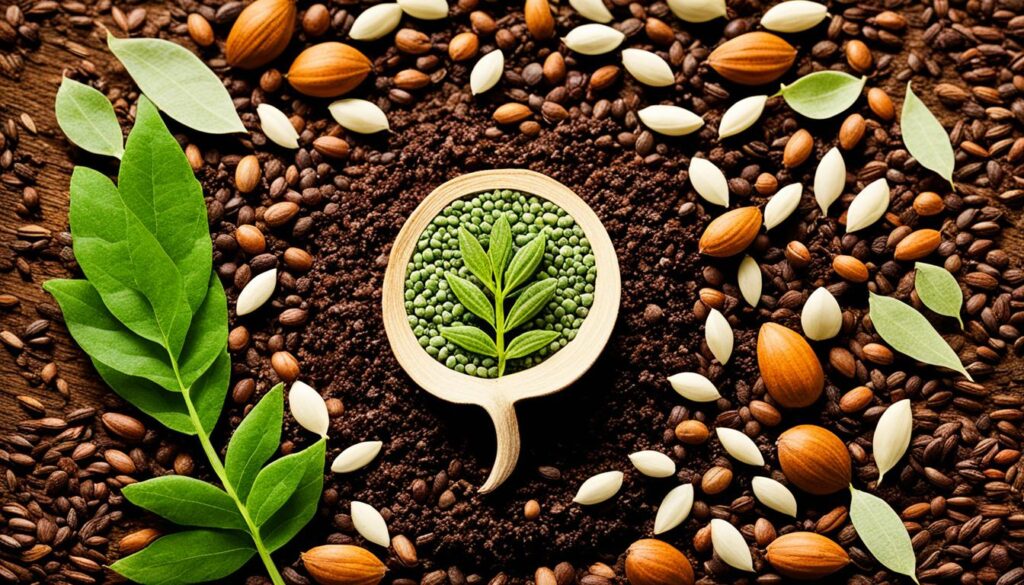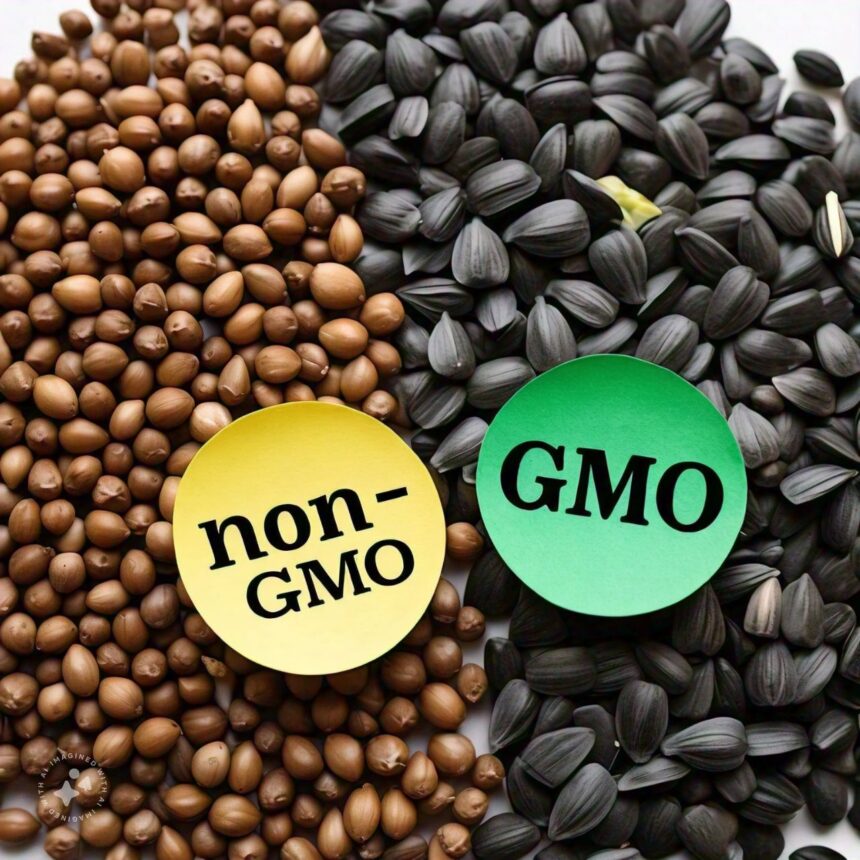So, you’re chatting with your neighbor, Jane, who just harvested her first batch of homegrown tomatoes. She excitedly tells you, “These are from non-GMO seeds!” You smile and nod, but deep down, you’re wondering what that really means.
What’s the difference between GMO and Non-GMO seeds, and why does it matter so much to her? With so much talk around these terms, you may be feeling a bit lost.
But in this article, we’ll break down the basics, helping you understand the key differences and why they’re significant for farmers, consumers, and the environment.
Let’s get started!
What Are GMO Seeds?
Genetically modified organisms (GMOs) are now a big topic in agriculture. It stands for genetically modified organisms, which are plants, animals, or microorganisms whose genetic material has been altered using genetic engineering techniques.
By implication, genetically modified (GM) seeds are seeds whose genetic material have been altered to produce certain desired results.
These alterations involve adding, deleting, or changing segments of DNA to achieve specific traits that do not occur naturally in the species. Traits such as increase yield, pest resistance, enhanced size and taste etc.
Overview of the Genetic Engineering Process
Genetic engineering involves identifying a desirable trait in one organism, isolating the gene responsible for that trait, and inserting it into the genetic material of the target organism.
For example, a gene from a bacterium that provides resistance to pests may be inserted into the DNA of a crop plant to make it resistant to those pests.
Techniques used in genetic engineering include recombinant DNA technology, CRISPR (Clustered Regularly Interspaced Short Palindromic Repeats), and gene splicing.
Non-GMO Seeds
Non-GMO seeds are those that have not been genetically modified through artificial genetic engineering. They are produced through traditional breeding techniques.
These techniques involve selecting parent plants with desirable traits and crossbreeding them to produce offspring that combine those traits.
Natural breeding methods rely on the existing genetic variation within a species and may take several generations to achieve the desired results.

Origin of GMO and Non-GMO seeds
A Brief History of GMO Seeds
Let’s take a trip back to the 1980s when scientists first developed the tools to insert foreign genes into plant cells. This was the dawn of agricultural biotechnology.
In 1994, the Flavr Savr tomato became the first genetically modified food crop to be approved for sale by the U.S. Food and Drug Administration (FDA). The tomato was engineered to have a longer shelf life by delaying the ripening process.
Early uses of GMO seeds primarily focused on improving crop resistance to pests, diseases, and environmental conditions. For instance, Bacillus thuringiensis (Bt) corn, which produces a bacterial toxin that deters insect pests, was introduced in the mid-1990s and became one of the most widely planted GMO crops.
Key Milestones in Genetic Modification:
- 1996: Enter Roundup Ready soybeans by Monsanto. These soybeans could survive glyphosate herbicide treatments, making weed control a breeze without harming the crop. It was a game-changer for farmers.
- 2003: Golden Rice a GMO was designed to combat vitamin A deficiency in developing countries, showed the humanitarian potential of GMOs. However, its journey has been rocky due to regulatory and acceptance hurdles.
- 2012: CRISPR-Cas9 technology emerged, making genetic engineering more precise and accessible. This tool has the potential to accelerate the creation of new GMO crops with beneficial traits, pushing the boundaries of what’s possible in agriculture.
A Brief History of Non-GMO Seeds
Long before the high-tech world of GMOs, traditional breeding was the name of the game. Farmers have been saving and selecting seeds from their best-performing plants for thousands of years, gradually improving crop yields and resilience.
The early 20th century brought hybridization into the picture. By crossing different plant varieties, breeders could combine desirable traits like disease resistance and high yield into a single plant. Hybrid seeds quickly became a hit in commercial farming due to their superior performance.
The mid-20th century saw significant strides in seed purity and preservation. Seed banks and germplasm repositories were established to conserve genetic diversity and ensure a steady supply of high-quality seeds.
What is the difference between GMO and Non-GMO seeds?
The primary difference between GMO and non-GMO seeds lies in their genetic makeup and the methods used to produce them. Here’s a breakdown of the key differences:
1. Genetic Modification
- GMO Seeds: These are seeds from organisms whose genetic material has been altered using genetic engineering techniques. For example, genes from bacteria or other plants might be inserted into crops to give them resistance to pests, herbicides, or harsh environmental conditions.
- Non-GMO Seeds: These seeds come from plants that have not been genetically modified. They are produced through traditional breeding methods, such as cross-pollination, hybridization, and selection. This process relies on natural genetic variations and the natural reproduction of plants.
2. Methods of Breeding
- GMO Seeds: Genetic modification involves laboratory techniques to change the DNA sequence of a plant. This can include adding genes from different species, which may not naturally interbreed. The goal is often to enhance specific traits, such as disease resistance, increased yield, or tolerance to herbicides.
- Non-GMO Seeds: Breeding is done through natural methods such as cross-pollination, hybridization, and selective breeding. These methods have been used for centuries to enhance desirable traits in plants, such as improved flavor, texture, and resistance to diseases and pests.
3. Environmental and Health Considerations
- GMO Seeds: The use of GMOs has raised concerns regarding potential environmental impacts, such as the development of herbicide-resistant weeds and the effect on non-target organisms like beneficial insects. There is also ongoing debate about the long-term health effects of consuming GMOs, though many scientific organizations and regulatory bodies assert their safety.
- Non-GMO Seeds: Non-GMO seeds are often preferred by those who seek to avoid the potential risks associated with genetic modification. They support biodiversity and are less likely to contribute to issues such as pesticide resistance and environmental contamination.
4. Certification and Labeling
- GMO Seeds: Seeds and crops that are genetically modified are typically subject to regulatory approval and must be labeled as GMO in many countries. This labeling is intended to inform consumers about the nature of the food they are purchasing.
- Non-GMO Seeds: Non-GMO seeds are not subject to genetic modification and are usually labeled as such. These seeds are grown using traditional agricultural practices and are often favored by consumers looking for organic or sustainably produced food.
5. Versatility and Adaptability
- GMO Seeds: These seeds are often designed to perform well under specific conditions, such as resistance to particular herbicides or pests. While they may offer higher yields and better resistance to certain challenges, their genetic uniformity can reduce biodiversity.
- Non-GMO Seeds: They maintain genetic diversity and adaptability, allowing them to thrive in a variety of conditions without the need for synthetic chemicals. This diversity is beneficial for long-term sustainability and ecosystem health.

Hybrid Seeds
Hybrid seeds have also become popular in recent years. They come from mixing two different plants of the same type. This can happen naturally or by breeders who help it along. The aim is to get plants that grow better, resist diseases, or taste better through natural ways.
Hybrid seeds are made without genetic engineering, unlike GMOs. They are different from heirloom seeds, which have been around for a long time and stay true to their type. Hybrid seeds might not keep their good traits when grown again, unlike heirloom seeds.
Hybrid seeds have changed crops like broccoli and kale over many years. Breeders have mixed traits from different plants to create new ones. This has given us the variety of Brassica vegetables we enjoy today.
Hybrid seeds can be good for growing more food and fighting diseases. But they might not always grow the same way again. Gardeners and farmers saving seeds for later should be careful with hybrids.
Organic Seeds: A Natural Alternative
If you care about the planet and want to grow food safely, you might look for GMO-free seeds. Organic seeds are a great choice. They’re made without harmful chemicals like pesticides or herbicides.
These seeds can be saved and replanted, keeping their special traits. They’re like heirloom seeds, known for their unique taste and strength. Choosing organic seeds helps the planet and keeps us healthy.
- Organic seeds are non-GMO and grown without harmful chemicals
- They are often open-pollinated, allowing for seed saving and genetic trait preservation
- Organic farming methods promote sustainability and environmental protection
- Organic seeds provide a natural alternative to genetically engineered or hybrid varieties
Organic seeds might not be as strong as GMO or hybrid ones, but they’re better for the earth. By picking organic seeds, you help make farming without chemicals the norm. You support the growth of heirloom varieties and open-pollinated crops.
Non-GMO Seeds vs Organic Seeds
- While non-GMO seeds are not genetically engineered, they are not necessarily organic. Organic seeds must meet specific standards set by organic certification bodies, including the absence of synthetic pesticides and fertilizers in their production.
- Non-GMO seeds can be grown using conventional agricultural methods that may include the use of synthetic chemicals, whereas organic seeds must be produced in compliance with organic farming practices.
- Consumers should look for both non-GMO and organic labels if they seek seeds that meet both criteria.
FAQs About GMO and Non-GMO Seeds
1. Are GMO seeds safe to eat?
Many scientific organizations and regulatory bodies assert that GMO foods are safe to eat. However, there is ongoing debate and research about the long-term health effects of consuming GMOs.
2. Are non-GMO seeds healthier?
Non-GMO seeds are often preferred by those who want to avoid potential risks associated with GMOs. They are also commonly used in organic farming, which emphasizes natural growing practices.
3. How do I know if seeds are GMO or non-GMO?
GMO seeds are usually labeled as such and are subject to regulatory approval. Non-GMO seeds are often labeled as non-GMO and are commonly found in organic seed catalogs.
4. Can I grow non-GMO seeds in any climate?
Yes, non-GMO seeds can be grown in a variety of climates. They maintain genetic diversity, which allows them to adapt to different environmental conditions.
5. Are non-GMO seeds more expensive than GMO seeds?
The cost of non-GMO seeds can vary. In some cases, they may be more expensive due to their organic certification or specialized breeding. However, they can also be cost-effective in the long run by reducing the need for synthetic inputs.
6. Can GMO seeds cross-pollinate with non-GMO plants?
Yes, GMO plants can cross-pollinate with non-GMO plants if they are grown nearby. This can lead to the unintentional spread of genetically modified traits.
7. Are there any countries that ban GMO seeds?
Yes, several countries have restrictions or bans on the cultivation and sale of GMO seeds. These regulations vary widely depending on the country and the specific GMO in question.
Conclusion
The difference between GMO and non-GMO seeds extends beyond their genetic makeup to their broader implications for health, environment, and agriculture.
GMO seeds, created through genetic engineering, offer benefits like increased yield and pest resistance but raise concerns about long-term health effects and environmental impact. Non-GMO seeds, produced through natural breeding methods, promote biodiversity and sustainable farming practices, aligning with a growing demand for natural and organic products.
By understanding these distinctions, consumers and farmers can make informed choices that reflect their values and contribute to a healthier, more sustainable future.




